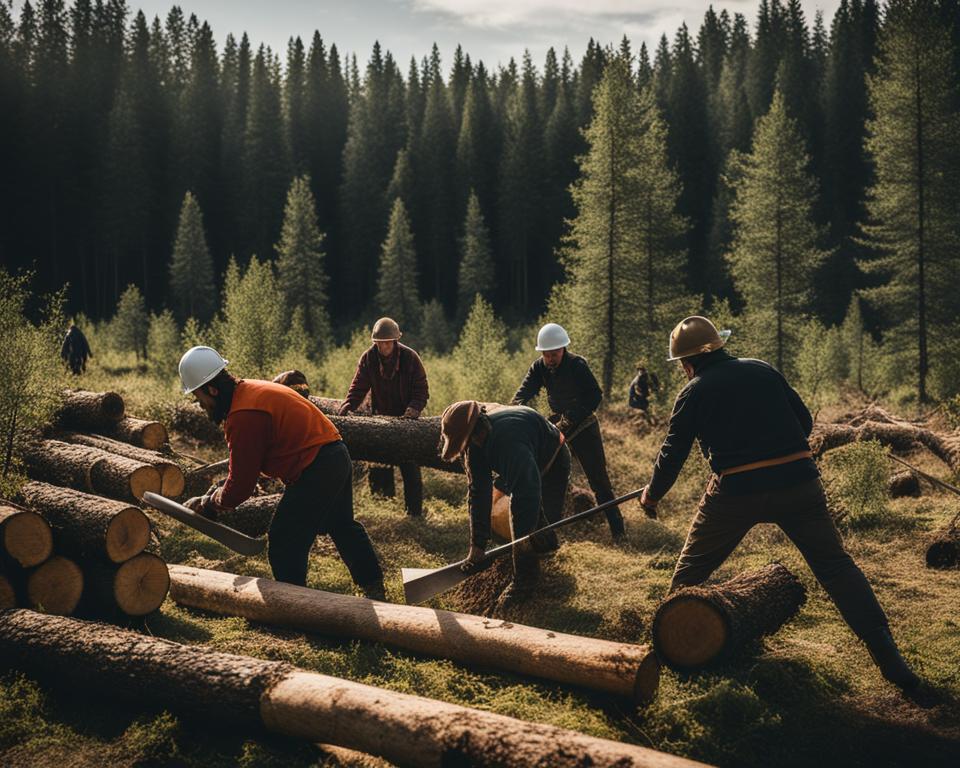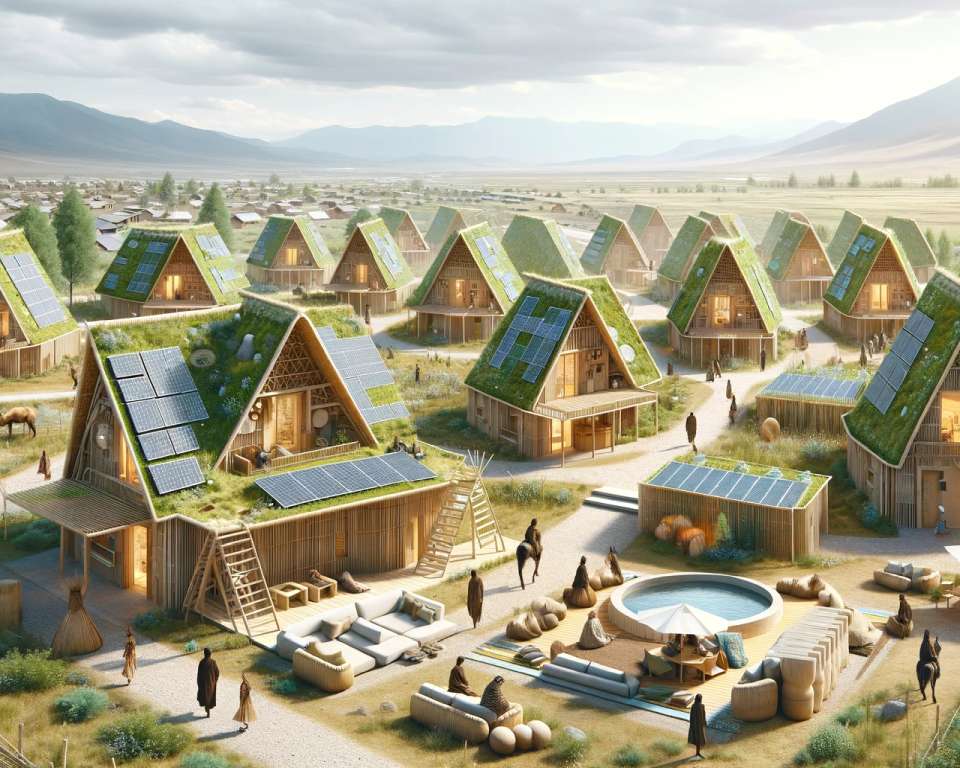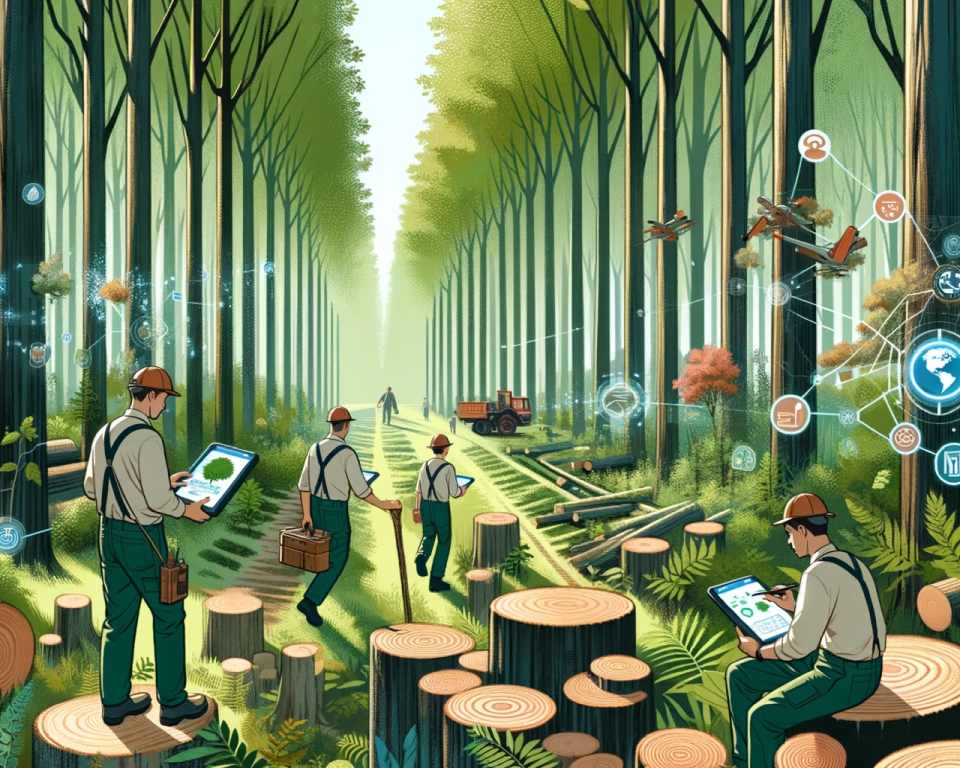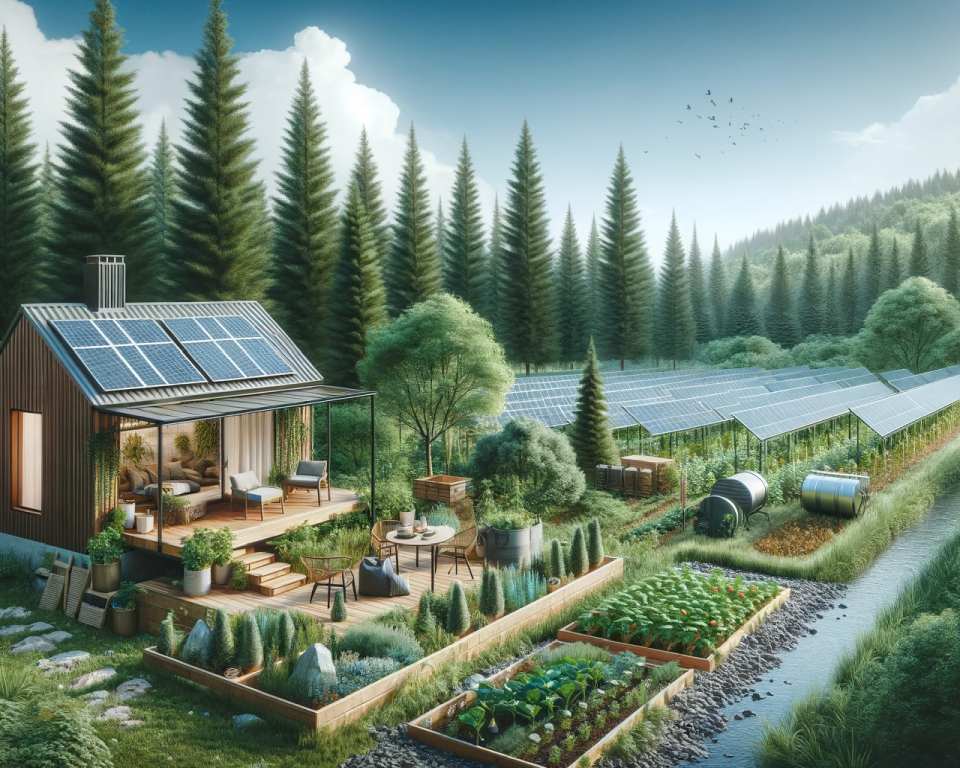Creating a Sustainable Living Environment in the Wilderness
Welcome to our informative article on sustainable wilderness living, where we explore the benefits of embracing an eco-friendly outdoor lifestyle and living off-grid. In this section, we will delve into the concept of sustainable wilderness living, highlighting its significance in today’s world. By adopting sustainable living practices, we can establish self-sufficient and environmentally friendly outdoor living experiences that harmonize with nature.
Imagine waking up surrounded by pristine natural beauty, breathing in the fresh air, and thriving in a close connection with the wilderness. This is the essence of sustainable wilderness living. By prioritizing eco-friendly choices and minimizing our ecological footprint, we can create a lifestyle that not only nurtures the planet but also nurtures our soul.
Living off-grid allows us to disconnect from conventional utilities and rely on renewable energy sources such as solar power, wind energy, and hydroelectricity. This not only reduces our reliance on fossil fuels but also offers a sense of independence and self-sufficiency.
Through sustainable wilderness living, we can make conscious choices to protect and preserve the natural environment. By minimizing waste, conserving water, and practicing sustainable farming techniques, we contribute to the sustainability of the ecosystem.
Join us as we explore the principles of sustainable development, the importance of forests in wilderness living, and the role of resilient homes for nomadic tribes. We will also delve into sustainable forestry practices and the benefits of sustainable housing. Our aim is to provide you with valuable insights and inspiration for creating a sustainable living environment in the wilderness.
The Principles of Sustainable Development for Protecting Nature in the Wilderness
The principles of sustainable development are essential for safeguarding and enhancing nature in the wilderness. These principles guide us in creating a harmonious balance between human needs and the conservation of natural resources.
Planning and design play a crucial role in implementing sustainable development initiatives in the wilderness. By considering the natural resource aspects of sustainable development, such as land, water, habitat, and soils, we can ensure that our actions are environmentally responsible and aligned with long-term ecological goals.
- Sustainable land use planning involves preserving and minimizing the impact on fragile ecosystems, while maximizing the potential for sustainable economic activities.
- Protecting water resources is crucial for maintaining the health of aquatic ecosystems, as well as ensuring a sustainable water supply for both human and wildlife populations.
- Prioritizing the preservation of natural habitats and biodiversity allows us to protect endangered species and maintain the overall ecological balance in the wilderness.
- Conserving soils through sustainable farming practices and land management techniques helps prevent erosion, maintain soil fertility, and protect vital ecosystems.
“Sustainable development is about finding innovative solutions that meet our present needs without compromising the ability of future generations to meet their own needs.” – Gro Harlem Brundtland
By adhering to these sustainable development principles in our planning and design processes, we can create development projects that prioritize the protection and enhancement of nature. This approach ensures the preservation of wilderness areas, allowing us to enjoy the beauty and benefits of nature while safeguarding it for future generations.
Next, we will explore how the implementation of sustainable principles can help nomadic tribes build resilient homes in harsh environments.
Adapting to Harsh Environments: Building Resilient Homes for Nomadic Tribes
Building resilient homes is crucial for nomadic tribes living in harsh environments. In order to withstand extreme weather conditions and provide long-term sustainability, it is important to incorporate sustainable architecture and key design features.

Resilient homes are designed to withstand the challenges of harsh environments while providing safety, comfort, and sustainability for nomadic communities. By utilizing weather-resistant materials, these homes can withstand extreme temperatures, strong winds, and other environmental factors.
Flexible structures are another essential aspect of resilient homes. These structures are designed to adapt to changing environments and can be easily dismantled and transported when necessary. This flexibility allows nomadic tribes to maintain their traditional way of life while ensuring their homes can be relocated as needed.
Energy-efficient solutions also play a crucial role in resilient home design. By incorporating energy-saving technologies such as solar panels, efficient insulation, and low-energy appliances, these homes can reduce their environmental impact and provide cost-effective energy solutions.
Water management systems are another important feature of resilient homes. These systems allow for the collection, storage, and efficient use of water resources, ensuring a sustainable water supply for nomadic communities even in arid regions.
Resilient homes not only provide a safe and comfortable living environment but also contribute to the preservation of nomadic cultures and traditions. By integrating sustainable architecture and key design features, we can ensure that nomadic tribes can thrive in harmony with their harsh environments while maintaining their unique way of life.
The Vital Role of Forests in Sustainable Wilderness Living
Forests are an essential component of sustainable wilderness living. They are not only beautiful and serene but also play a crucial role in maintaining the balance of our planet. Here we explore the vital importance of forests in sustainable wilderness living, touching upon their carbon absorption capacity, economic value, and the ecosystem services they provide.
“Forests are the lungs of the Earth, absorbing carbon dioxide and releasing oxygen.”
The Carbon Absorption Powerhouse
Forests are nature’s carbon absorption powerhouses. Through the process of photosynthesis, trees and plants absorb carbon dioxide from the atmosphere, mitigating the effects of climate change. The captured carbon is then stored in the forest ecosystem, helping to reduce greenhouse gas emissions. Forests are our mighty allies in combatting global warming and preserving the delicate balance of our planet.
Economic Value and Livelihood Support
Forests hold significant economic value, providing livelihoods for millions of people around the world. The timber industry, for instance, relies on sustainably harvested wood from forests to meet global demand for various products. Forests also offer opportunities for ecotourism, creating jobs and attracting visitors who seek to experience the beauty and wonders of untouched wilderness.
Furthermore, forests provide essential resources in the form of non-timber forest products (NTFPs) like medicinal plants, fruits, nuts, and fibers. These resources not only contribute to local economies but also preserve traditional knowledge and cultural practices tied to forest ecosystems.
Ecosystem Services and Biodiversity Hotspots
Forests are home to countless species of plants, animals, and microorganisms, making them biodiversity hotspots. They provide habitats, food, and protection for a myriad of species, contributing to the balance and resilience of ecosystems. Forests also regulate water cycles, prevent soil erosion, and act as natural filters, purifying the air and water that sustain life on Earth.
The presence of forests in wilderness areas ensures the preservation of these critical ecosystem services, allowing us to coexist harmoniously with nature and nurture a sustainable living environment.
Sustainable Forestry: Balancing Conservation and Livelihoods
Sustainable forestry plays a critical role in striking a balance between conservation and livelihoods. By mimicking natural patterns of disturbance and regeneration, we can ensure the long-term health and sustainability of our forests.
At the heart of sustainable forestry is the practice of sustainable forest management. This approach focuses on protecting biodiversity, reducing deforestation, promoting selective harvesting, and conserving natural forests. By following these principles, we can maintain healthy ecosystems while preserving the economic benefits that forests provide.
One key organization that certifies sustainable forest management practices is the Forest Stewardship Council (FSC). The FSC sets rigorous standards that ensure responsible forest management, environmental protection, and the rights of indigenous communities. Forest products carrying the FSC certification label provide consumers with the assurance that the wood or paper comes from sustainably managed forests.

“Sustainable forest management is the key to maintaining the delicate balance between conservation and meeting human needs. By adopting responsible practices and supporting organizations like the FSC, we can ensure that future generations can enjoy the benefits of forests for years to come.”
Through sustainable forestry practices, we can secure the numerous benefits that forests offer us. These benefits include carbon sequestration, habitat preservation, water regulation, and the provision of renewable resources. By managing our forests sustainably, we guarantee that they continue to support our communities, protect our environment, and preserve our natural heritage.
The Benefits of Sustainable Housing for Nomadic Tribes
Sustainable housing initiatives provide numerous benefits for nomadic tribes. These initiatives not only address the pressing need for housing but also contribute to cultural preservation, improved living conditions, and environmental sustainability. By implementing sustainable housing solutions, nomadic tribes can thrive while preserving their unique way of life.
One of the primary advantages of sustainable housing for nomadic tribes is the preservation of cultural traditions. Traditional housing designs and materials can be incorporated into modern sustainable housing solutions, allowing communities to maintain their cultural identity and connection to their ancestral heritage. This ensures that generations to come can continue to practice their traditions and pass them on to future generations.
Sustainable housing also significantly enhances living conditions for nomadic tribes. These homes offer improved insulation, ventilation, and access to clean water and sanitary facilities. This translates into better health outcomes and a higher quality of life. By providing shelter that is resistant to extreme weather conditions and offers a comfortable and safe environment, sustainable housing promotes overall well-being and stability within nomadic communities.
Access to basic amenities is another crucial benefit of sustainable housing initiatives. These homes can facilitate access to essential services such as education, healthcare, and sanitation. By bringing these services closer to nomadic tribes, sustainable housing promotes inclusivity and ensures that community members can lead more fulfilling and prosperous lives.

Reducing the environmental impact is a top priority when it comes to sustainable housing. These initiatives focus on utilizing renewable energy sources, implementing energy-efficient technologies, and promoting sustainable construction practices. By minimizing resource consumption and decreasing carbon emissions, nomadic tribes can contribute to a more sustainable future.
Sustainable housing also increases the resilience of nomadic communities. By providing durable and adaptable homes, these initiatives help nomadic tribes withstand the challenges of climate change and other environmental pressures. Additionally, by engaging nomadic communities in the design and planning process, these housing solutions empower individuals to take an active role in shaping their own futures.
Overall, sustainable housing initiatives offer a holistic approach to meeting the housing needs of nomadic tribes. These initiatives improve living conditions, preserve cultural heritage, provide essential amenities, and ensure environmental sustainability. By embracing sustainable housing solutions, nomadic tribes can thrive while preserving their unique way of life for generations to come.
The Future of Sustainable Housing for Nomadic Tribes
As we look to the future, it is vital that sustainable housing initiatives continue to evolve and adapt to the changing needs and contexts of nomadic communities. By incorporating innovative technologies, engaging with local stakeholders, and promoting knowledge sharing, we can ensure that sustainable housing remains a cornerstone of cultural preservation, improved living conditions, and sustainable development for nomadic tribes worldwide.
The Role of Sustainable Forestry Certification and Training
Sustainable forestry certification is an essential component of responsible forest stewardship. Organizations like the Rainforest Alliance and the Forest Stewardship Council (FSC) play a crucial role in ensuring that forestry businesses meet strict environmental, social, and economic criteria. Through sustainable forestry certification, these organizations promote sustainable practices that preserve forest ecosystems and support local communities.

Forest Stewardship Council (FSC) certification is widely recognized as a gold standard for sustainable forestry. It guarantees consumers that the products they purchase, such as wood and paper, come from responsibly managed forests. FSC-certified forests adhere to rigorous standards, including the protection of biodiversity, the respect for indigenous rights, and the promotion of fair trade. By choosing products with the FSC label, consumers can contribute to the conservation and preservation of our precious forest resources.
“Sustainable forestry certification ensures the responsible management of forests, balancing environmental, social, and economic considerations. It provides consumers with the confidence that they are making environmentally friendly choices and supports the long-term sustainability of our forests.”
However, sustainable forestry certification alone is not enough to create lasting change. Forest communities also require proper training and support to adopt and implement sustainable practices effectively. The Rainforest Alliance and the Forest Stewardship Council work with forest communities to provide training programs that empower them with the knowledge and skills necessary for sustainable forest management.
This comprehensive approach acknowledges the importance of involving forest communities in conservation efforts. Through training, forest communities learn techniques to protect biodiversity, prevent deforestation, and practice responsible logging. They also gain business skills that enable them to enhance their economic opportunities through sustainable forest-based enterprises.
The combination of sustainable forestry certification and comprehensive training programs ensures that forests are managed responsibly, taking into account both environmental and social considerations. By supporting these initiatives, we can foster a future where forests are protected, communities thrive, and sustainable livelihoods are achieved.
Principles of Sustainable Forestry Management
In order to safeguard forest biodiversity and prevent deforestation, it is crucial for forestry businesses to prioritize responsible logging practices and embrace sustainable forestry management. By adhering to these principles, we can ensure the long-term health and vitality of our forests while meeting our societal and economic needs.
One of the key aspects of sustainable forestry management is the protection of forest biodiversity. Forests are incredibly diverse ecosystems that support a wide range of plant and animal species. By safeguarding their habitats and promoting sustainable logging practices, we can preserve this biodiversity for future generations.
Deforestation prevention is another critical goal of sustainable forestry management. Deforestation results in the loss of forest cover and the destruction of valuable habitats. By implementing deforestation prevention strategies, such as reforestation efforts and sustainable land-use practices, we can mitigate the negative environmental impacts and maintain the integrity of our forests.
Responsible logging practices play a vital role in sustainable forestry management. This involves using reduced-impact techniques for timber harvesting, such as carefully planning and executing logging operations to minimize damage to the surrounding environment. By implementing responsible logging practices, we can ensure the regeneration and sustainable use of our forest resources.
“Sustainable forestry management requires a holistic approach that balances the ecological, social, and economic aspects of forest stewardship. It is our responsibility to manage our forests in a way that meets the needs of the present without compromising the ability of future generations to meet their own needs.”

Maintaining natural forests is another core principle of sustainable forestry management. Natural forests provide essential ecosystem services, such as carbon sequestration, water regulation, and soil conservation. By preserving these forests, we can secure these valuable services and support the overall health and resilience of our natural ecosystems.
In conclusion, sustainable forestry management is crucial for the preservation of forest biodiversity, the prevention of deforestation, and the promotion of responsible logging practices. By embracing these principles, we can ensure the sustainable use and protection of our forests, while also meeting our societal and economic needs.
The Future of Sustainable Wilderness Living
As the global demand for sustainable practices continues to rise, it is crucial to actively involve communities and stakeholders in sustainable wilderness living initiatives. By fostering community involvement, providing education and awareness, fostering partnerships, embracing adaptability, and implementing sustainable practices for natural forests, we can pave the way for a future where wilderness living thrives in harmony with nature.
Community involvement plays a vital role in sustainable wilderness living. Empowering local communities to actively participate in decision-making processes and encouraging their input ensures that their unique perspectives and needs are considered. This collaborative approach creates a sense of ownership and shared responsibility, fostering a lasting commitment to sustainable practices in wilderness areas.
Education and awareness are fundamental in driving the adoption of sustainable practices. By providing information on the benefits and importance of sustainable living, as well as practical guidance on implementing eco-friendly practices, we can inspire individuals and communities to embrace a sustainable lifestyle. This knowledge empowers individuals to make informed choices and actively contribute to the preservation of natural forests and the overall well-being of the wilderness.
Partnerships with governmental and non-governmental organizations are crucial for the success of sustainable wilderness living. Collaborating with these entities allows us to leverage their expertise, resources, and networks to create impactful initiatives that address global challenges. Together, we can implement innovative solutions, share best practices, and support the development of policies that promote sustainable practices for natural forests and the preservation of wilderness areas.
FAQ
What is sustainable wilderness living?
Sustainable wilderness living allows individuals to embrace an eco-friendly outdoor lifestyle and live off-grid in harmony with nature. It involves implementing sustainable living practices to establish a self-sufficient and environmentally friendly outdoor living experience.
How do the principles of sustainable development protect nature in the wilderness?
The principles of sustainable development focus on the natural resource aspects of sustainable development, such as land, water, habitat, and soils. By considering and applying these principles, municipalities, developers, and planners can create sustainable development projects that prioritize the protection and enhancement of nature.
What features should resilient homes for nomadic tribes in harsh environments have?
Resilient homes for nomadic tribes should utilize sustainable architecture and incorporate features such as weather-resistant materials, flexible structures, energy-efficient solutions, and water management systems. These homes provide safety, comfort, and sustainability for nomadic communities.
How do forests contribute to sustainable wilderness living?
Forests play a vital role in sustainable wilderness living as they absorb carbon dioxide, produce oxygen, regulate the global climate, and provide ecosystem services. They also have significant economic value, supporting the livelihoods of millions of people and contributing to the global economy.
What is sustainable forestry and how does it balance conservation and livelihoods?
Sustainable forestry aims to balance conservation and livelihoods by mimicking natural patterns of disturbance and regeneration. It involves practices such as selective harvesting, reducing deforestation, and the conservation of natural forests. Certification by organizations like the Forest Stewardship Council ensures responsible forest stewardship.
What are the benefits of sustainable housing for nomadic tribes?
Sustainable housing initiatives provide numerous benefits for nomadic tribes, including preserving cultural traditions, enhancing living conditions, providing access to basic amenities, reducing environmental impact, and increasing the resilience of nomadic communities. These initiatives allow nomadic tribes to thrive while preserving their way of life.
How do sustainable forestry certification and training support sustainable wilderness living?
Sustainable forestry certification, led by organizations like the Rainforest Alliance and the Forest Stewardship Council, ensures that forestry businesses meet strict environmental, social, and economic criteria. Training is also provided to forest communities, supporting their efforts in conservation, sustainable practices, and business skills. This comprehensive approach enables responsible forest stewardship and supports sustainable livelihoods.
What are the principles of sustainable forestry management?
Sustainable forestry management involves protecting forest biodiversity, preventing deforestation, implementing responsible logging practices, maintaining natural forests, and using reduced-impact techniques for timber harvesting. Adhering to these principles allows forestry businesses to sustainably manage forests and contribute to their long-term health.
How can communities and stakeholders be involved in sustainable wilderness living initiatives?
Promoting community involvement, education, partnerships, adaptability, and sustainable practices for natural forests is crucial in involving communities and stakeholders in sustainable wilderness living initiatives. By working collaboratively, we can create a future where wilderness living is truly sustainable and in harmony with nature.







